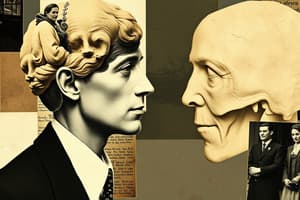Podcast
Questions and Answers
What is the primary finding from Tolman's experiments with rats in the maze?
What is the primary finding from Tolman's experiments with rats in the maze?
- Rats can develop a cognitive map even without a reward. (correct)
- Rats take longer to learn without any rewards.
- Rats learn how to navigate mazes only when rewarded.
- Rats only remember the maze layout for a short period.
What is meant by 'latent learning' as described in the studies with rats?
What is meant by 'latent learning' as described in the studies with rats?
- Learning that requires constant reinforcement for retention.
- Learning that occurs only through trial and error.
- Learning that is demonstrated immediately after reinforcement.
- Learning that is not observed until there is a reason to demonstrate it. (correct)
What characterizes insight problem solving according to the gestalt approach?
What characterizes insight problem solving according to the gestalt approach?
- It involves sudden realization or an 'A ha!' moment. (correct)
- It relies on methodical trial and error.
- It requires a lengthy process of exploration.
- It can only be achieved through external rewards.
What role does reconstruction play in insight problem solving?
What role does reconstruction play in insight problem solving?
What was the outcome of the rats that explored the maze with no reinforcement after they were motivated by food?
What was the outcome of the rats that explored the maze with no reinforcement after they were motivated by food?
What is the primary characteristic of classical conditioning?
What is the primary characteristic of classical conditioning?
What type of stimulus is known to elicit a reflexive response without prior learning?
What type of stimulus is known to elicit a reflexive response without prior learning?
In the context of classical conditioning, what becomes of the neutral stimulus after it is paired with the unconditioned stimulus?
In the context of classical conditioning, what becomes of the neutral stimulus after it is paired with the unconditioned stimulus?
Which of the following terms describes the reaction elicited by the conditioned stimulus?
Which of the following terms describes the reaction elicited by the conditioned stimulus?
What does the unconditioned response (UCR) represent in classical conditioning?
What does the unconditioned response (UCR) represent in classical conditioning?
Who was a key figure in the development of classical conditioning?
Who was a key figure in the development of classical conditioning?
Which of the following best defines a neutral stimulus (NS) in classical conditioning?
Which of the following best defines a neutral stimulus (NS) in classical conditioning?
In classical conditioning, what is the role of the unconditioned stimulus (UCS)?
In classical conditioning, what is the role of the unconditioned stimulus (UCS)?
What is the role of the unconditioned stimulus in classical conditioning?
What is the role of the unconditioned stimulus in classical conditioning?
Which is a characteristic of the conditioned stimulus?
Which is a characteristic of the conditioned stimulus?
What is stimulus discrimination in classical conditioning?
What is stimulus discrimination in classical conditioning?
What effect does repeated presentation of the conditioned stimulus without the unconditioned stimulus have?
What effect does repeated presentation of the conditioned stimulus without the unconditioned stimulus have?
Which of the following is true about stimulus generalization?
Which of the following is true about stimulus generalization?
Which principle states that the conditioned stimulus must come before the unconditioned stimulus?
Which principle states that the conditioned stimulus must come before the unconditioned stimulus?
What occurs during the process of extinction in classical conditioning?
What occurs during the process of extinction in classical conditioning?
What is an unconditioned response?
What is an unconditioned response?
What characteristic must the conditioned stimulus possess during conditioning?
What characteristic must the conditioned stimulus possess during conditioning?
What is spontaneous recovery in classical conditioning?
What is spontaneous recovery in classical conditioning?
What is the main purpose of reinforcement in operant conditioning?
What is the main purpose of reinforcement in operant conditioning?
Which of the following describes positive reinforcement?
Which of the following describes positive reinforcement?
In the context of behavior modification, what role does negative reinforcement play?
In the context of behavior modification, what role does negative reinforcement play?
What is shaping in the context of behavior modification?
What is shaping in the context of behavior modification?
Which of these statements reflects a common misconception about punishment in operant conditioning?
Which of these statements reflects a common misconception about punishment in operant conditioning?
What is the primary effect of removing an undesirable stimulus in negative reinforcement?
What is the primary effect of removing an undesirable stimulus in negative reinforcement?
What type of punishment is described when a model is punished, decreasing the learner's motivation to imitate the behavior?
What type of punishment is described when a model is punished, decreasing the learner's motivation to imitate the behavior?
According to Bandura's Bobo Doll Experiment, which scenario makes children less likely to behave aggressively towards the doll?
According to Bandura's Bobo Doll Experiment, which scenario makes children less likely to behave aggressively towards the doll?
What percentage of child abuse victims reportedly become abusive parents?
What percentage of child abuse victims reportedly become abusive parents?
Which of the following factors has research suggested may also contribute to aggression, beyond exposure to violent media?
Which of the following factors has research suggested may also contribute to aggression, beyond exposure to violent media?
What is one criticism of the research linking violent media exposure to aggression?
What is one criticism of the research linking violent media exposure to aggression?
In the context of learning theories, what is suggested about learning that occurs without punishment or reward?
In the context of learning theories, what is suggested about learning that occurs without punishment or reward?
According to Bandura's early studies, what effect does exposure to television violence have on children?
According to Bandura's early studies, what effect does exposure to television violence have on children?
Which of the following describes the behavior of children who witness aggressive acts by their parents?
Which of the following describes the behavior of children who witness aggressive acts by their parents?
What is the process of progressively reinforcing behaviors that are closer to a desired behavior called?
What is the process of progressively reinforcing behaviors that are closer to a desired behavior called?
Which of the following best describes a primary reinforcer?
Which of the following best describes a primary reinforcer?
In shaping, after reinforcing a response that closely resembles the desired behavior, what is the next step?
In shaping, after reinforcing a response that closely resembles the desired behavior, what is the next step?
What happens when reinforcement is discontinued?
What happens when reinforcement is discontinued?
Which option is an example of a secondary reinforcer?
Which option is an example of a secondary reinforcer?
Which reinforcement schedule is the most effective for teaching a new behavior?
Which reinforcement schedule is the most effective for teaching a new behavior?
What does partial reinforcement refer to?
What does partial reinforcement refer to?
Which type of reinforcer is linked to primary reinforcers for its value?
Which type of reinforcer is linked to primary reinforcers for its value?
Flashcards
Unconditioned Stimulus (UCS)
Unconditioned Stimulus (UCS)
A stimulus that naturally triggers an automatic response.
Unconditioned Response (UCR)
Unconditioned Response (UCR)
The automatic response to an unconditioned stimulus.
Neutral Stimulus (NS)
Neutral Stimulus (NS)
A stimulus that initially does not produce a response.
Conditioned Stimulus (CS)
Conditioned Stimulus (CS)
Signup and view all the flashcards
Conditioned Response (CR)
Conditioned Response (CR)
Signup and view all the flashcards
Stimulus Discrimination
Stimulus Discrimination
Signup and view all the flashcards
Stimulus Generalization
Stimulus Generalization
Signup and view all the flashcards
Extinction in Classical Conditioning
Extinction in Classical Conditioning
Signup and view all the flashcards
Learning
Learning
Signup and view all the flashcards
Classical Conditioning
Classical Conditioning
Signup and view all the flashcards
Training Phase
Training Phase
Signup and view all the flashcards
Spontaneous Recovery
Spontaneous Recovery
Signup and view all the flashcards
Higher-Order Conditioning
Higher-Order Conditioning
Signup and view all the flashcards
Operant Conditioning
Operant Conditioning
Signup and view all the flashcards
Reinforcement
Reinforcement
Signup and view all the flashcards
Punishment
Punishment
Signup and view all the flashcards
Shaping
Shaping
Signup and view all the flashcards
Latent learning
Latent learning
Signup and view all the flashcards
Cognitive map
Cognitive map
Signup and view all the flashcards
Insight learning
Insight learning
Signup and view all the flashcards
Insight problem
Insight problem
Signup and view all the flashcards
Reconstruction in insight problems
Reconstruction in insight problems
Signup and view all the flashcards
Primary Reinforcer
Primary Reinforcer
Signup and view all the flashcards
Secondary Reinforcer
Secondary Reinforcer
Signup and view all the flashcards
Continuous Reinforcement
Continuous Reinforcement
Signup and view all the flashcards
Partial Reinforcement
Partial Reinforcement
Signup and view all the flashcards
Extinction
Extinction
Signup and view all the flashcards
Reinforcement Schedule
Reinforcement Schedule
Signup and view all the flashcards
Ratio Schedules
Ratio Schedules
Signup and view all the flashcards
Vicarious Learning
Vicarious Learning
Signup and view all the flashcards
Vicarious Punishment
Vicarious Punishment
Signup and view all the flashcards
Vicarious Reinforcement
Vicarious Reinforcement
Signup and view all the flashcards
Bandura's Bobo Doll Experiment
Bandura's Bobo Doll Experiment
Signup and view all the flashcards
Media Violence and Aggression
Media Violence and Aggression
Signup and view all the flashcards
Cognitive Learning
Cognitive Learning
Signup and view all the flashcards
Learning without Reinforcement
Learning without Reinforcement
Signup and view all the flashcards
Study Notes
Learning: Definition and Types
- Learning is a relatively permanent change in behavior brought about by experience or practice.
- Learning is categorized as behavior modification, encompassing: Classical Conditioning, Operant Conditioning (Instrumental Conditioning), Skill Learning (Motor Learning), Observational Learning, and Cognitive Learning Theory.
Classical Conditioning
- Classical conditioning involves learning to associate an involuntary response with a new stimulus.
- Key elements include:
- Unconditioned stimulus (UCS): A stimulus that naturally elicits a reflexive response (e.g., food).
- Unconditioned response (UCR): A natural, unlearned reaction to the UCS (e.g., salivation).
- Neutral stimulus (NS): A stimulus that does not initially elicit a response.
- Conditioned stimulus (CS): Initially a neutral stimulus, after repeated pairing with the UCS, elicits a response.
- Conditioned response (CR): A learned response to the CS (e.g., salivation to the bell).
- Classical conditioning history includes Pavlov (late 19th-early 20th century) and John B. Watson (20th century).
- Important principles include: CS must precede UCS, short time gap between CS and UCS, repeated pairings, and CS must be attention-capturing.
- Processes like stimulus discrimination (responding differently to similar, but distinct stimuli) and stimulus generalization (responding similarly to similar stimuli) result from classical conditioning.
Classical Conditioning: Elements In Action
- During training, the NS and UCS are repeatedly paired.
- The NS transforms into the CS.
- The CR is the behavior elicited by the CS.
Some Principles of Classical Conditioning
- The CS must precede the UCS.
- The time gap between CS and UCS must be short.
- Repetition is key during the training or acquisition phase.
- The CS should be attention-grabbing.
Stimulus Discrimination and Generalization
- Stimulus discrimination is an organism responding differently to various similar, but distinct stimuli.
- Stimulus generalization is an organism responding similarly to similar stimuli.
Extinction and Spontaneous Recovery
- Extinction: Gradual weakening and disappearance of a CR when the CS is presented repeatedly without the UCS.
- Spontaneous recovery: Return of a previously extinguished CR following a rest period.
Higher-Order Conditioning
- Second-order conditioning is a form where a neutral stimulus becomes a conditioned stimulus after being paired with a previously conditioned stimulus. Classical conditioning is a type of associative learning.
Operant Conditioning (Instrumental Conditioning)
- Operant conditioning focuses on how consequences influence future behavior.
- Reinforcement increases the likelihood of a behavior.
- Punishment decreases the likelihood of a behavior.
- Reinforcement and punishment can be either positive (adding a stimulus) or negative (removing a stimulus).
Reinforcement Schedules
- Continuous reinforcement: reinforcer is given each time the behavior occurs
- Partial reinforcement: reinforcer is not given each time
- Different schedules result in different response patterns. Fixed interval, variable interval, fixed ratio, variable ratio.
Shaping
- Shaping involves reinforcing successive approximations of a target behavior, making it easier to develop complex behaviors.
- Shaping is important when the target behavior is complex.
Primary and Secondary Reinforcement
- Primary reinforcers have innate reinforcing qualities (e.g., food, water).
- Secondary reinforcers gain reinforcing qualities through association with primary reinforcers (e.g., money, praise).
Behavior Modification
- Increasing a behavior: Positive reinforcement (adding a desirable stimulus) or negative reinforcement (removing an unpleasant stimulus).
- Decreasing a behavior: Positive punishment (adding an unpleasant stimulus) or negative punishment (removing a desirable stimulus).
Observational Learning (Modeling)
- Observational Learning: Learning by observing others and imitating their behaviors.
- Models can be live, verbal, or symbolic.
- Steps include attention, retention, reproduction, and motivation.
- Vicarious reinforcement and punishment affect motivation to imitate.
Cognitive Learning Theory
- Emphasis is on mental processes involved in learning.
- Latent learning suggests learning can occur without evident reinforcement. Gestalt approach: Insight problem-solving.
Learned Helplessness
- Learned helplessness describes a state where an organism seems to have no control over negative or threatening events.
- This can result in learned helplessness where individuals give up trying to overcome negative outcomes.
Additional Notes
Several studies, experiments, and real-world examples are mentioned. The text contains important figures and tables; although they aren't included here, students should refer to the images and tables to build a complete understanding.
Studying That Suits You
Use AI to generate personalized quizzes and flashcards to suit your learning preferences.




